Organizational structures define how departments interact and decision-making flows, crucial for both large and small businesses. They clarify employees' roles in achieving business goals, fostering unity across diverse functions.
A well-planned organizational structure lets employees know where they fit within the organization and how their role factors into the achievement of greater business goals.
In this article we dive into what makes a great organizational structure, types of structures (plus case studies & pro/con lists), and then some guidelines you can use to decide on the right organizational structure for your business.
What is an organizational structure?

An organizational structure defines how tasks are divided, coordinated, and supervised within a business. It determines the hierarchy and reporting relationships that guide workflow, communication, and decision-making.
An organization's structure is determined by the org design process, defining aspects like:
- the flow of information
- chain of command
- decision-making processes
The impact of an organizational structure is significant—it can enhance efficiency, clarify roles and responsibilities, and influence a company's culture and management style. If you’ve ever entered a new job and been handed an org chart by human resources, you’ve looked at an organizational structure.
Important takeaways:
- Roles and Hierarchy: Organizational structure clearly defines roles, responsibilities, and reporting, essential for efficient decision-making and workflows.
- Culture and Operations Impact: The structure greatly affects company culture, communication, and operational efficiency, impacting performance and morale.
- Need for Adaptability: A successful organizational structure must be flexible to adapt to business environment changes, supporting growth and evolution.
Quick Definition: Organizational charts
An organizational chart visually depicts a company's structure, illustrating departmental hierarchy and relationships. It clarifies reporting lines, aids communication, and assists in decision-making.
Throughout this article, I’ll share examples of organizational charts to illustrate each of the types of organizational structure I’m explaining, and provide real-life examples of companies that have adopted each type of organization.
The Key Elements of an organizational structure

To determine which organizational structure is best for your business, you’ll want to consider the following key elements:
- Span of control
- Departmentalization
- Chain of command
- Specialization
- Formalization
- Centralized vs decentralized organizational structures
Span of control
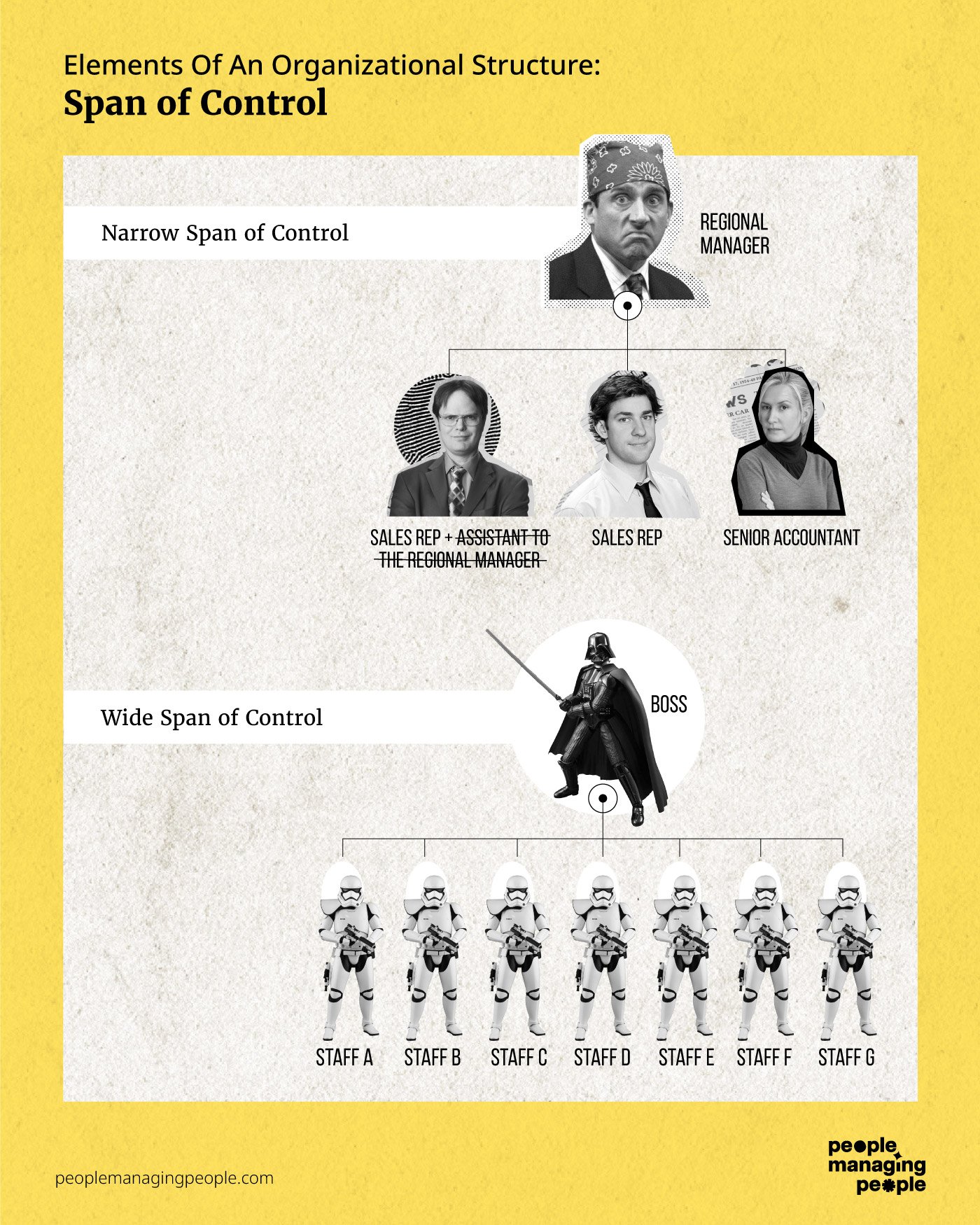
Span of control refers to the number of direct reports a manager has. It indicates how closely a manager can work with each team member, impacting the level of supervision and support they can provide.
A manager with a narrow span of control can closely interact with a few employees, fostering strong one-on-one relationships. In contrast, a manager overseeing many employees (e.g., 15-20) offers less individual attention, requiring more self-sufficient, skilled team members.
Factors influencing the span of control:
Organizational Size and Span of Control:
- Small Businesses: May have fewer managers, leading to broader spans of control and less one-on-one support.
- Large Organizations: Often have more management layers, providing lower-level employees with more personalized support.
Complexity and Supervision Needs:
- Complex Roles: Require more supervision, reducing the span of control to ensure adequate support.
- Simplified Roles: May allow for a wider span of control.
Manager and Employee Skill Levels:
- Experienced Managers: Can handle a wider span of control effectively.
- Less Experienced Managers: Best suited to a narrower span of control.
- Junior Employees: Benefit from a narrow span of control for greater direction and support.
Departmentalization
Departmentalization refers to how an organization breaks up employees into specialization groups.
Common Variations for Departmentalization:
- By Function: The usual approach in many organizations, such as marketing, HR, accounts payable, and sales.
- By Customer Profile, Location, Process, or Product: Alternative strategies for more tailored operational focus.
Key Benefits for Small Companies:
- Motivates employees by aligning them with specific goals.
- Enhances teamwork and mutual support within similar job roles.
- Increases focus and efficiency in achieving KPIs.
Chain of command
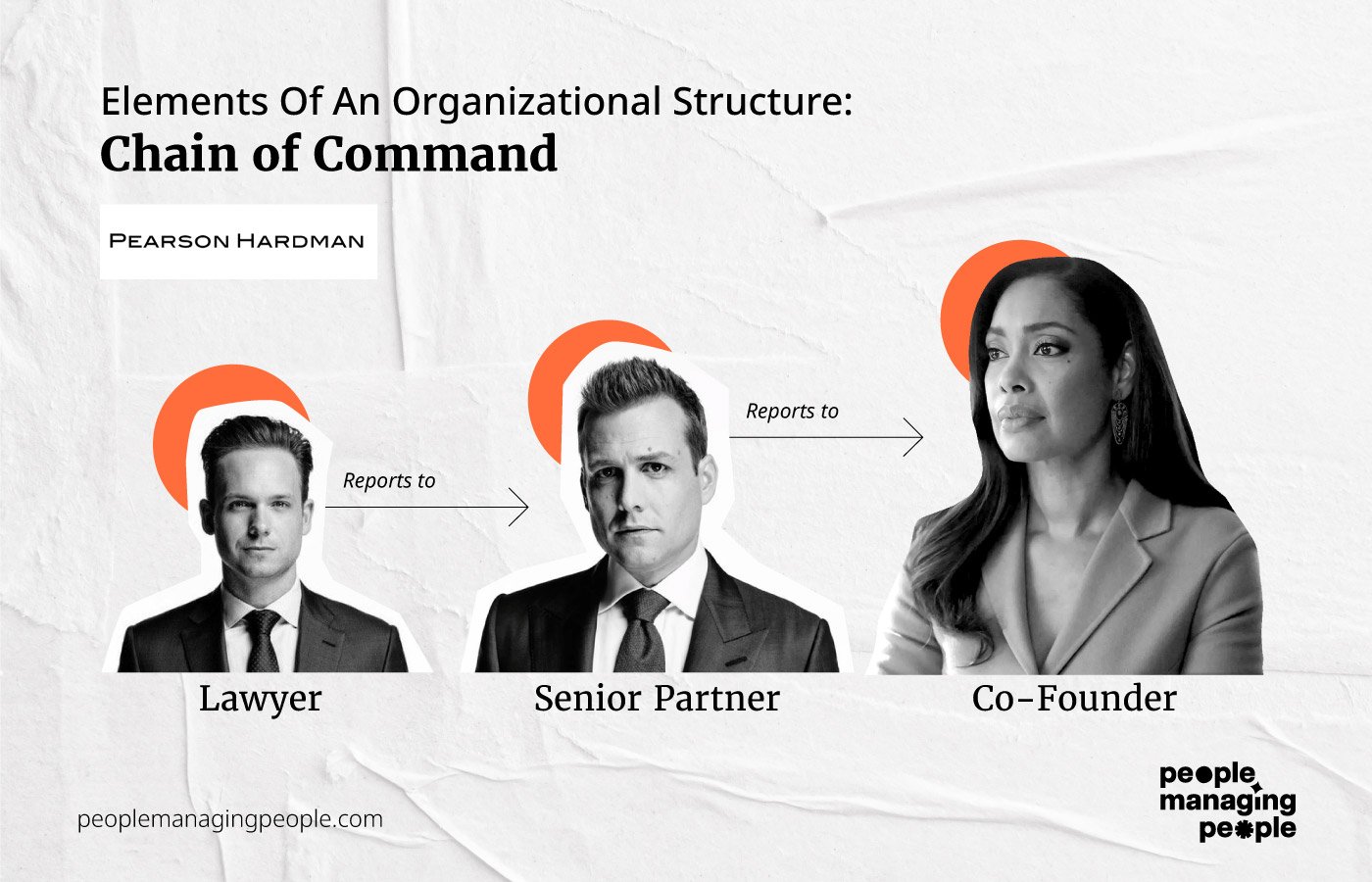
The chain of command is an organization’s hierarchy of reporting relationships. Sometimes known as the command structure, it demonstrates who reports to whom, and establishes a flow of communication for decision-making and approvals.
A traditional command structure:
| Chain of Command | Responsibilities | Typical Roles |
|---|---|---|
| Executive Management | Develops and implements growth strategies. Learns market trends to identify opportunities and threats. Oversees middle management, aligning their objectives with company goals. | - Chief executive officer (CEO) - Chief operating officer (COO) - EVP/SVP/VP (of: marketing, human resources, etc.) |
| Middle Management Reports to Executive Management | Focuses on achieving top-level management's goals. Manages front-line employees and allocates resources. Acts as a bridge between executive and individual contributors, ensuring goal alignment. | - Director - Division manager - Foreman - General manager |
| Individual Contributors Reports to Middle Management | Perform the daily activities vital to the company. Roles are industry-specific and focused. Essential for executing the strategies and plans developed by higher management levels. | - Office manager - Product developer - Project manager - Human resources specialist - Sales representative |
Specialization
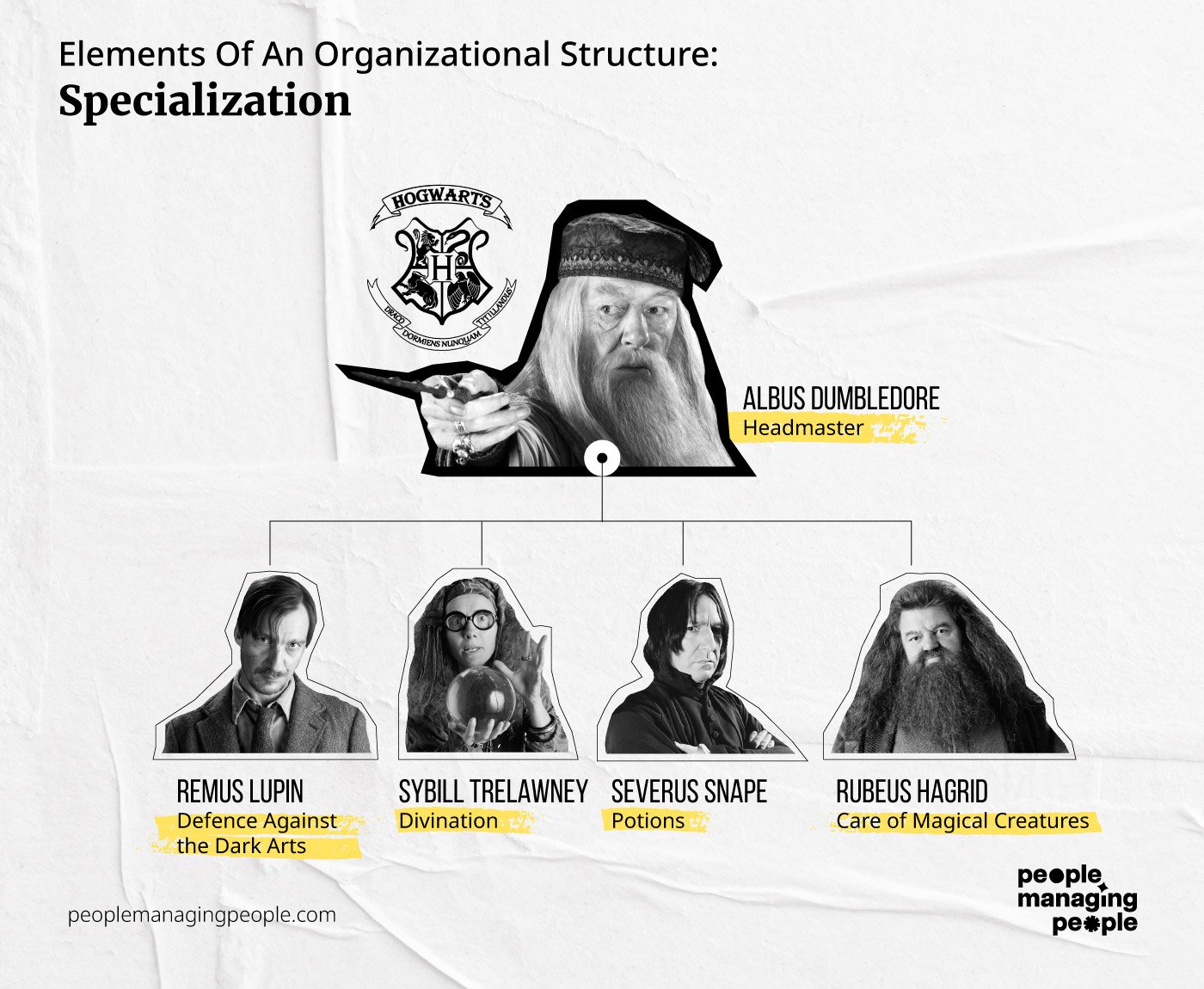
Specialization is how job roles are tailored to specific tasks or functions.
- Benefit: specialized job roles allow for focused expertise and quick proficiency.
- Risk: building your organizational structure based on specialization can create silos and reducing inter-departmental communication.
Balance specialization with opportunities for cross-functional collaboration to prevent siloed operations and foster a cohesive team environment. It is part of the role of executives and sometimes middle management to ensure appropriate cross-functional collaboration.
Formalization
Formalization refers to the amount of standardization throughout the organization. It involves having clearly defined job descriptions, functions, and systems, which guide employees in their duties.
Benefits of formalization include:
- Enhanced Clarity and Consistency: Standardized procedures provide clear guidelines, reducing confusion and ensuring uniformity in tasks.
- Improved Efficiency and Performance: Well-defined roles and processes streamline operations, leading to higher productivity.
Pro tip: Regularly review and update your organization's standard procedures to ensure they remain relevant and effective in facilitating smooth operations and employee understanding.
Centralized vs decentralized organizational structures
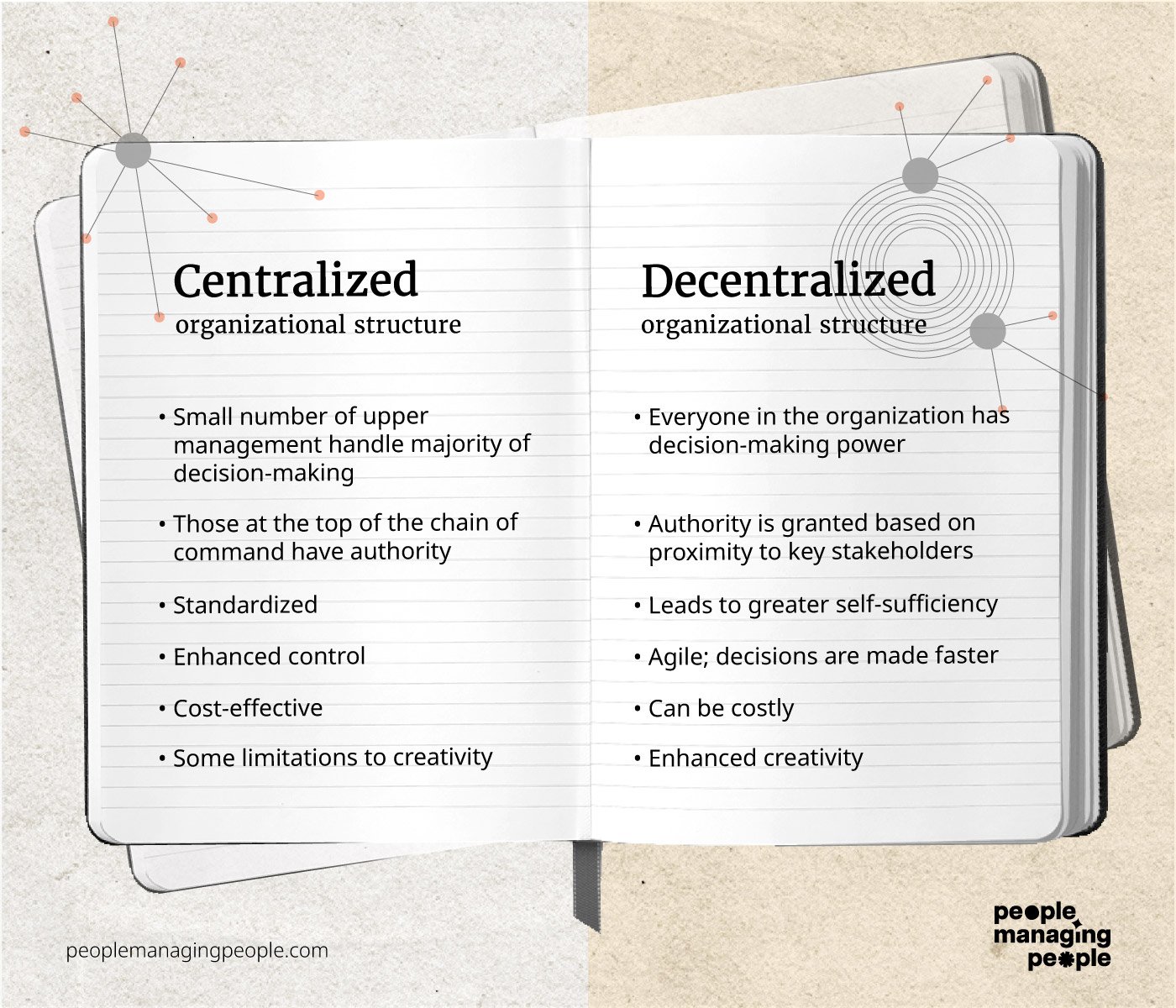
Centralized Organizational Structure: Decision-making is concentrated at the top level, often with a single leader like a CEO.
- Benefits: Ensures consistency in decisions, simplifies command chain.
- Drawbacks: Can limit autonomy and creativity at lower levels, slower decision-making process.
Decentralized Organizational Structure: Decision-making is distributed among various levels, promoting a democratic approach.
- Benefits: Encourages autonomy, faster decision-making, and innovation at lower levels.
- Drawbacks: Can lead to inconsistency in decisions, complex coordination among departments.
What to consider when choosing between a centralized or decentralized structure:
- Assess Business Size and Complexity: Centralized structures often suit smaller, less complex organizations, while decentralized structures are beneficial for larger, more complex ones.
- Evaluate the Need for Innovation: Decentralized structures can foster innovation and creativity.
- Understand Your Organizational Culture: Align the structure with your company's culture and values.
Types of organizational structure
There are several types of organizational structures. Each configuration caters to different business needs.

Whether your organization is a startup, small business, or large company, choosing an organizational structure to suit your needs will assist your employees in understanding their roles, succeeding at their duties, and strategic planning for growth.
Let’s take a look at some of the most common organizational structures, I've included what they are, some key takeaways, case studies, as well as some pros & cons for each so you can make an informed decision.
- Functional organizational structure
- Divisional organizational structure
- Process-Based Organizational Structure
- Matrix Organizational Structure
- Circular organizational structure
- Flat Organizational Structure
- Network Organizational Structure
Functional organizational structure
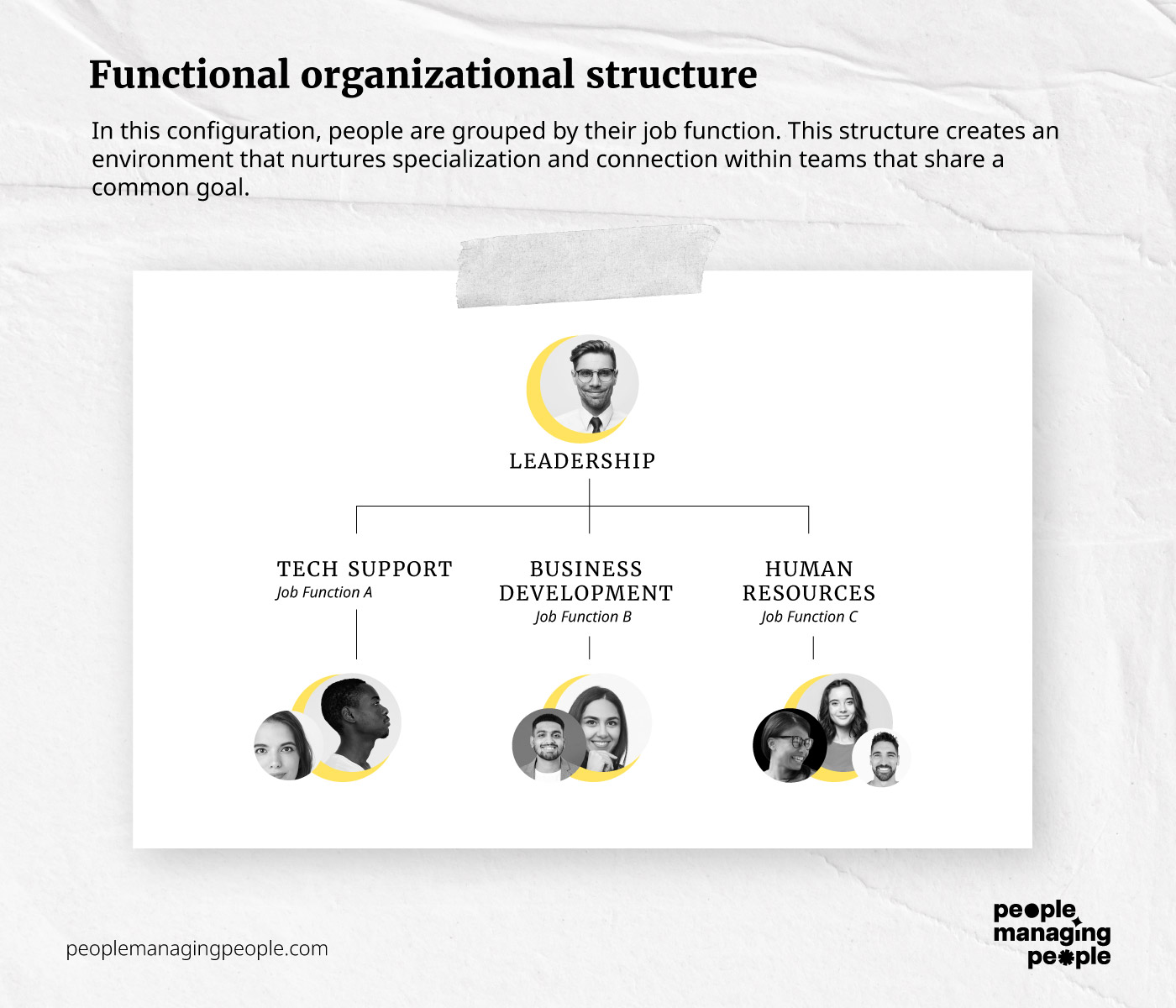
The functional organizational structure is one of the most common types. In this configuration, people are grouped by their job function.
For example, a company with this type of organizational structure might group all of their new business development people together, all of their tech support people together, and all of their human resources people together.
Key Takeaway: This structure creates an environment that nurtures specialization, and connection within teams that share a common goal.
Super-Successful: How Amazon used a functional organization structure to empower global growth
Amazon is an example of a company with a functional organizational structure. Though the company began with a lean, flat organization, as it grew it transitioned to a more traditional hierarchical structure.
Amazon's adoption of a functional organizational structure has facilitated its impressive growth and diversification into multiple sectors, including e-commerce, cloud computing, digital streaming, and artificial intelligence.
This structure allowed Amazon to efficiently manage its vast array of products and services while maintaining a strong central leadership and clear division of roles and responsibilities. This efficiency and clarity have been key factors in Amazon's ability to innovate and expand rapidly.
Enhance Communication Across Functions: Given the risk of silos in a functional structure, HR should prioritize initiatives that foster inter-departmental communication and collaboration just like Amazon. This can involve cross-functional projects, inter-departmental meetings, and team-building activities to ensure cohesive operations and a unified organizational culture.
Pros of Functional Organizational Structure:
- Enhanced Accountability: Clear roles improve responsibility and accountability.
- Skill Specialization: Employees can master their roles due to task stability.
- Process Improvement: Focused departments develop and implement efficiency-enhancing processes.
- Organized Communication: Well-defined chain of command ensures structured communication and decision-making.
Cons of Functional Organizational Structure:
- Departmental Silos: Risks limited inter-departmental communication, leading to inefficiencies.
- Interdependency Challenges: Lack of cross-departmental understanding hinders innovation and synergy.
- Limited Flexibility: May struggle to adapt in diverse markets or with multiple products.
Divisional organizational structure
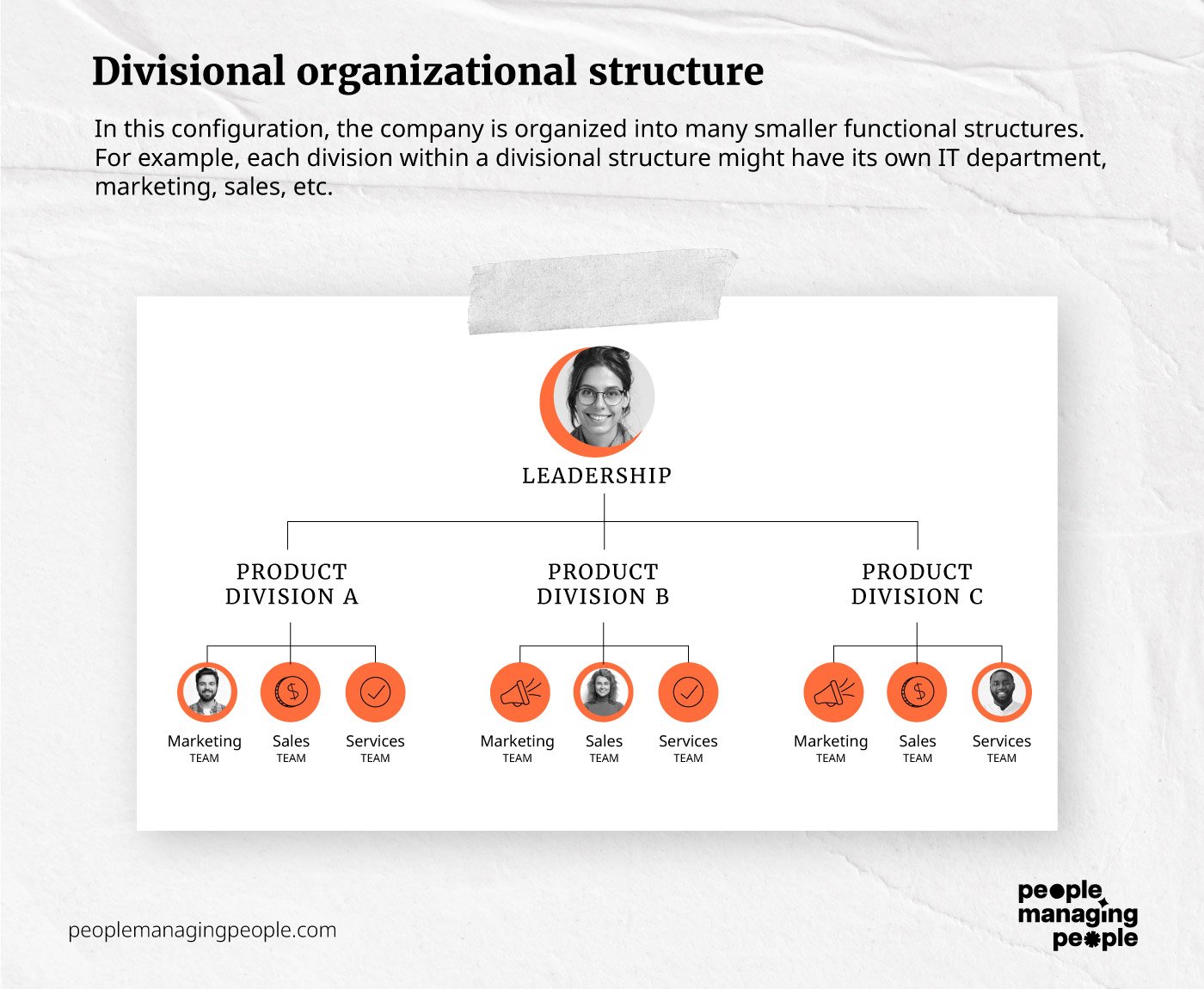
A divisional structure is one in which the company is organized into many smaller functional structures. For example, each division within a divisional structure might have its own IT department, marketing, sales, etc.
Three types of divisional structures:
- Product-based divisional structures :in which each division is focused on a certain product line
- Market-based divisional structures:in which the structure is based around customer profiles, industry, or markets
- Geographical divisional structures: in which the structure is based on districts, regions, and territories within which a company operates
GE's Divisional Approach: Tailoring for Market Agility and Efficiency
General Electric (GE) thrives with a divisional organizational structure due to its ability to focus on diverse market segments effectively.
This structure allows GE to operate various divisions independently, such as aviation, healthcare, and energy, each tailored to their specific market needs and dynamics.
Moreover, the divisional approach fosters agility and innovation within each unit, enabling GE to respond quickly to industry changes and capitalize on emerging opportunities, while maintaining overall strategic coherence under the GE brand.
Promoting Inter-Divisional Collaboration: GE's success with a divisional structure highlights the value of encouraging collaboration across divisions. HR can facilitate cross-divisional initiatives, such as knowledge sharing and learning programs, to leverage diverse expertise and foster a unified corporate culture despite the divisional segmentation.
Pros of Divisional Organizational Structure:
- Dedicated Leadership: Each division has its own leadership, supporting focused strategic objectives and securing necessary resources.
- Specialized Knowledge and Culture: Divisions can develop deep expertise and a unique culture, tailored to specific products, regions, or markets.
Cons of Divisional Organizational Structure:
- Potential for Internal Competition: Divisions may compete for funding and resources, leading to internal conflicts.
- Risk of Internal Incompatibilities: Highly specialized divisions may inadvertently overlap or conflict with each other's business areas.
Process-Based Organizational Structure
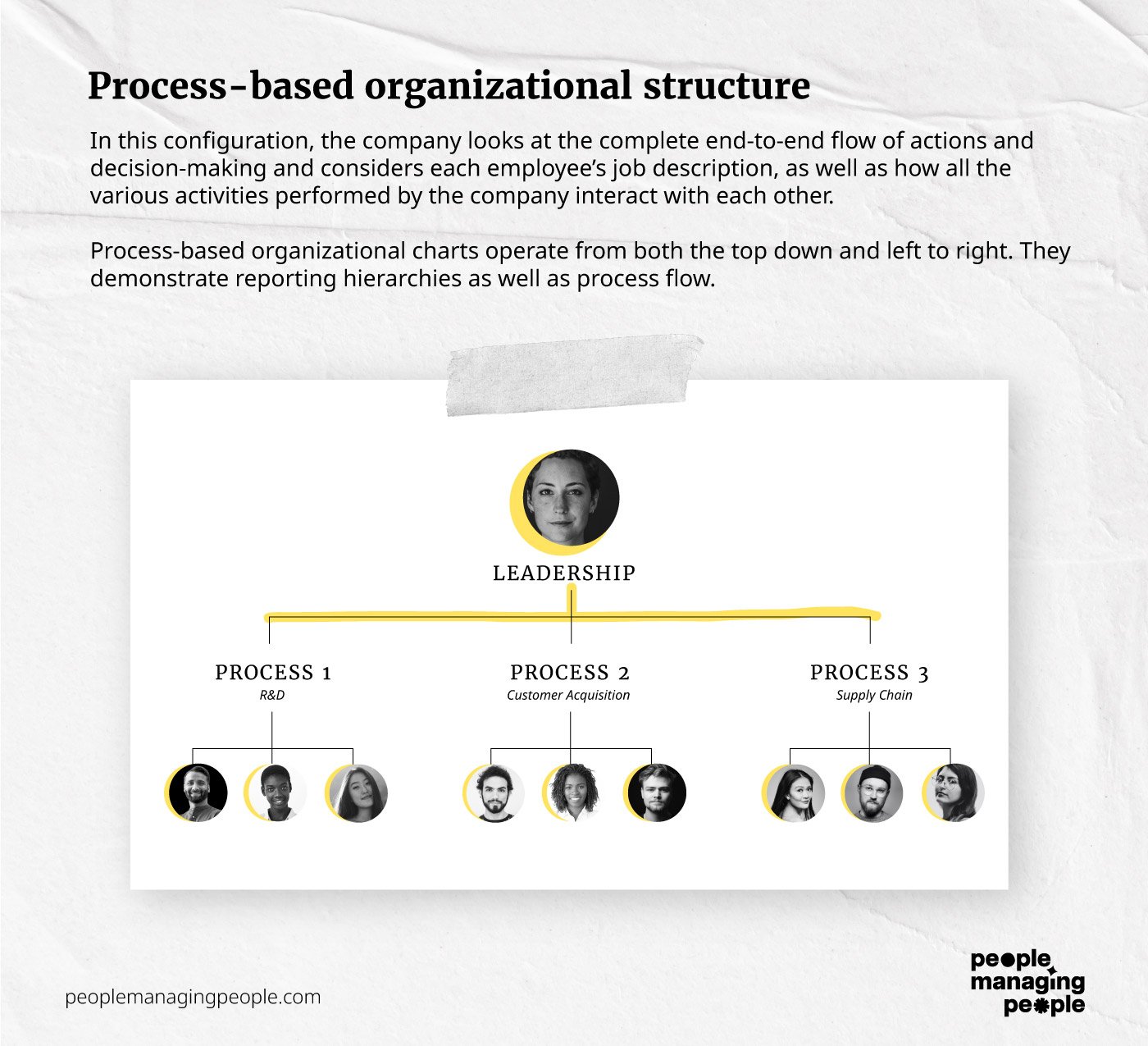
Process-based organizations are (you guessed it!) based on an organization’s processes. They look at the complete end-to-end flow of actions and decision-making and consider each employee’s job description, as well as how all the various activities performed by the company interact with each other.
Businesses best suited for process-based organizational structures:
- Manufacturing Firms: Streamlines production processes.
- Service Providers: Enhances service delivery efficiency.
- Tech Companies: Supports agile development cycles.
- Logistics Companies: Optimizes supply chain management.
- Healthcare Providers: Improves patient care workflows.
Process-based organizational charts operate both from the top down, as well as from left to right. They demonstrate both reporting hierarchies as well as process flow
Pros of Process-Based Organizational Structure:
- Enhances Efficiency: Streamlines workflows, adapting easily to market changes.
- Promotes Teamwork: Encourages collaboration both within and between departments.
- Maintains Momentum: Motivates teams to keep pace and sustain productivity.
Cons of Process-Based Organizational Structure:
- Risk of Silos: May limit cross-departmental communication.
- Inter-Departmental Tensions: Slow pace in one area can cause frustrations and hinder overall output.
Matrix Organizational Structure

Matrix structures do not align with a traditional hierarchical structure. In these structures, employees have dual reporting relationships.
Key features of a matrix organizational structure:
- Dual Reporting: Employees report based on job function (solid line) and product/division (dotted line).
- Balanced Decision-Making: Multiple chains of command enhance decision flexibility.
- Enhanced Communication: Projects managed by various units, promoting resource sharing and diverse perspectives.
Starbucks' Strategy: Navigating Global Expansion with a Matrix Framework
Starbucks exemplifies the matrix structure's effectiveness, blending functional and geographical strategies.
This approach empowers Starbucks to manage its vast global presence while adapting to regional preferences, crucial in the dynamic coffee industry. It ensures that innovation and responsiveness are at the forefront, aligning with the diverse tastes and cultural nuances of its global customer base.
This organizational agility is essential for Starbucks' continued growth and market relevance.
Balancing business needs: Adopting a matrix structure can help businesses achieve a balance between global efficiency and local market sensitivity, a key desire for organizations aiming to expand their international footprint while maintaining strong local connections.
Pros of Matrix Organizational Structure:
- Enhanced Collaboration: Encourages cooperation across teams and divisions.
- Skill Development: Offers employees exposure to diverse job functions.
Cons of Matrix Organizational Structure:
- Risk of Confusion: Multiple approval layers can lead to uncertainty.
- Authority Issues: Potential for disputes and blame-shifting during challenges.
Circular organizational structure
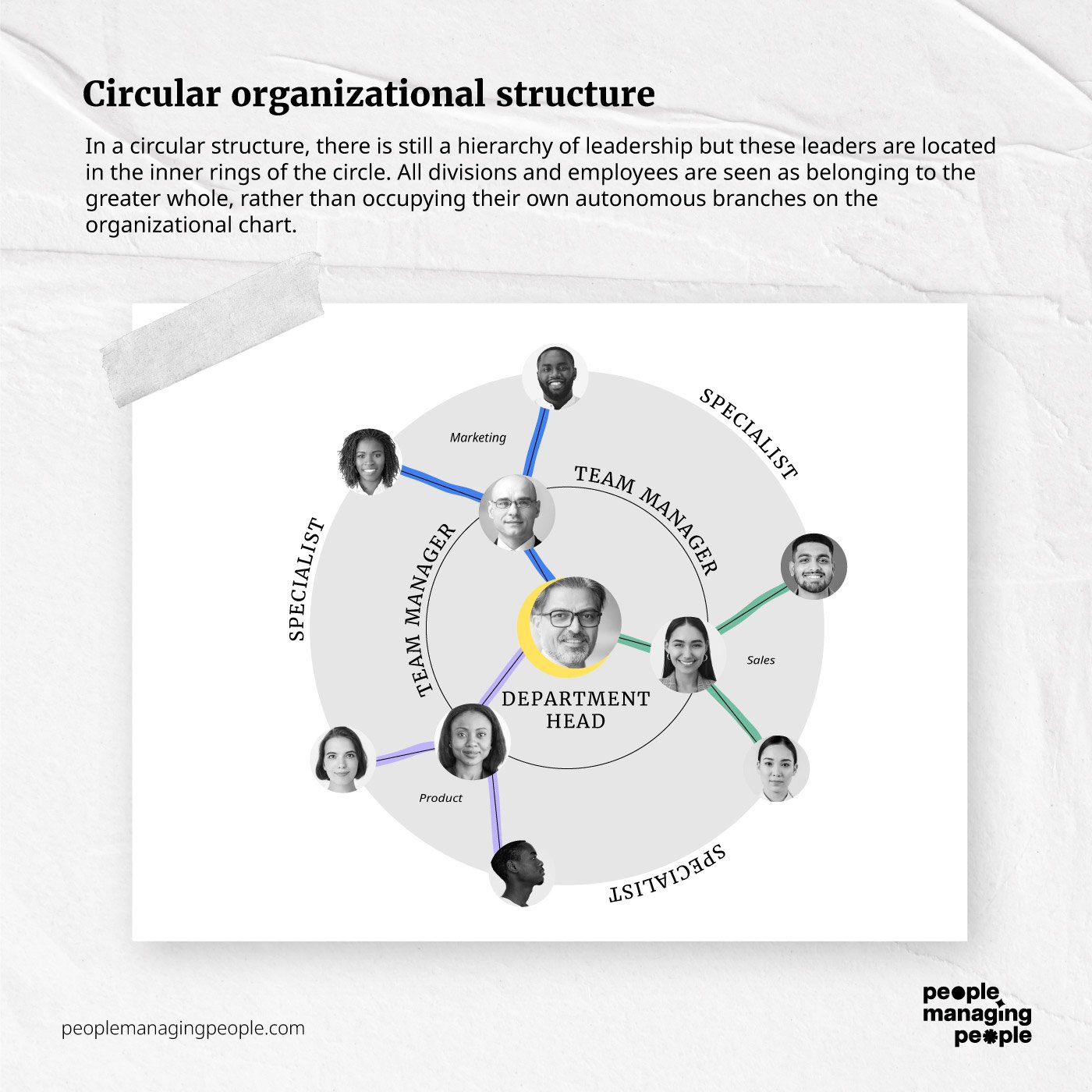
In a circular structure, leadership is organized differently from traditional hierarchies. Leaders are positioned in the inner circles, emphasizing their role at the center of the organization, where they transmit their vision outward.
Key features of a circular structure:
- Centralized Leadership: Leaders positioned at the center.
- Outward Vision Transmission: Leaders send their vision to outer layers.
- Free Flow of Ideas: Encourages open communication and idea exchange.
- Unified Whole: Views all divisions and employees as part of the larger organization.
- Enhanced Unity: Fosters a sense of belonging and unity among members.
Circular structures suit businesses valuing open communication, psychological safety, teamwork, and innovation. Ideal for startups, creative industries, and knowledge-based sectors, they break down traditional hierarchies, promoting idea exchange and unity among teams.
Pros of Circular Organizational Structure:
- Enhanced Communication: Promotes information flow and collaboration across the organization.
- Alignment with Objectives: Facilitates employee alignment with company goals.
- Encourages Sharing: Fosters a culture of sharing and collaboration among teams.
Cons of Circular Organizational Structure:
- Complexity for New Hires: New employees may struggle to understand reporting lines and decision processes.
- Different from Tradition: Differs significantly from traditional models, requiring adjustment for newcomers.
Flat Organizational Structure
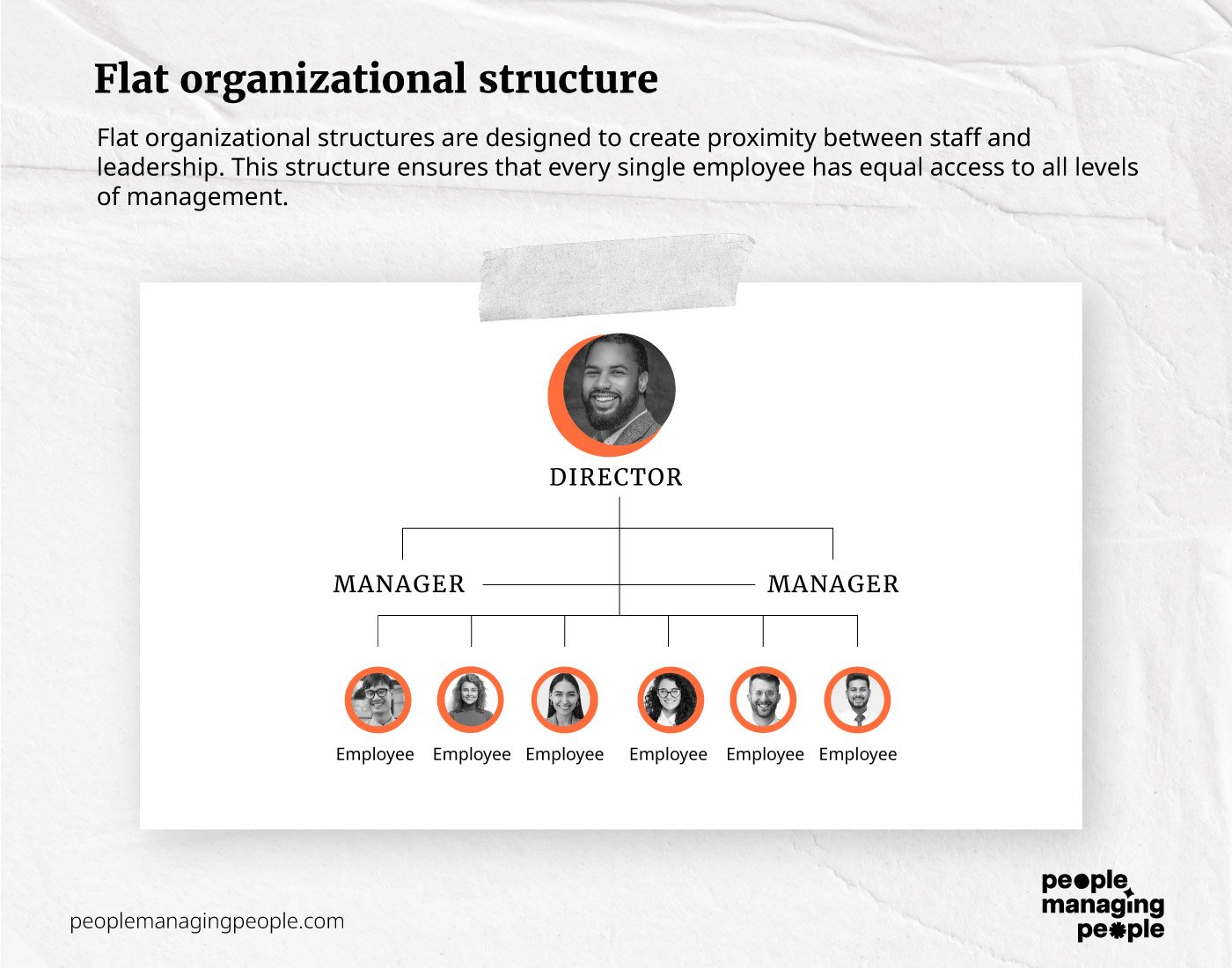
Flat organizational structures are designed to create proximity between staff and leadership. Rather than being built as a pyramid, with many layers of individuals between low-level employees and upper management, flat organizational structures ensure that every single employee has equal access to all levels of management.
Businesses that typically use a flat hierarchy:
- Small to Medium Businesses: Efficient decision-making and open communication.
- Startups: Quick adaptation, innovation, and collaboration.
- Technology Industry: Agility and rapid development.
- Creative Agencies: Fosters creativity and teamwork.
- Knowledge-Based Sectors: Encourages idea exchange and individual contributions.
Collaboration and Decentralization: Google's Flatarchy Approach
Google's use of a flat organizational structure (aka Flatarchy) sets it apart and contributes to its success. This approach promotes a culture of innovation and open communication, allowing employees to collaborate freely and contribute to the company's growth.
Decision-making is decentralized, enabling swift responses to market changes. With leaders accessible and approachable, Google fosters a dynamic environment where ideas flourish, making it a unique and successful tech giant.
Key takeaway: Flatarchy = Approachable Leadership. Promote accessibility and approachability among leaders to enhance employee engagement and innovation.
Pros of Flat Organizational Structure:
- Autonomy and Equality: Employees experience greater autonomy and relate to leaders as equals.
- Quick Decision-Making: Speeds up decision-making and fosters direct relationships with upper management.
Cons of Flat Organizational Structure:
- Confusion in Reporting: Potential for confusion in reporting relationships.
- Increased Leadership Involvement: Senior leaders may need to resolve disputes and participate in decision-making they wouldn't in other structures.
Network Organizational Structure
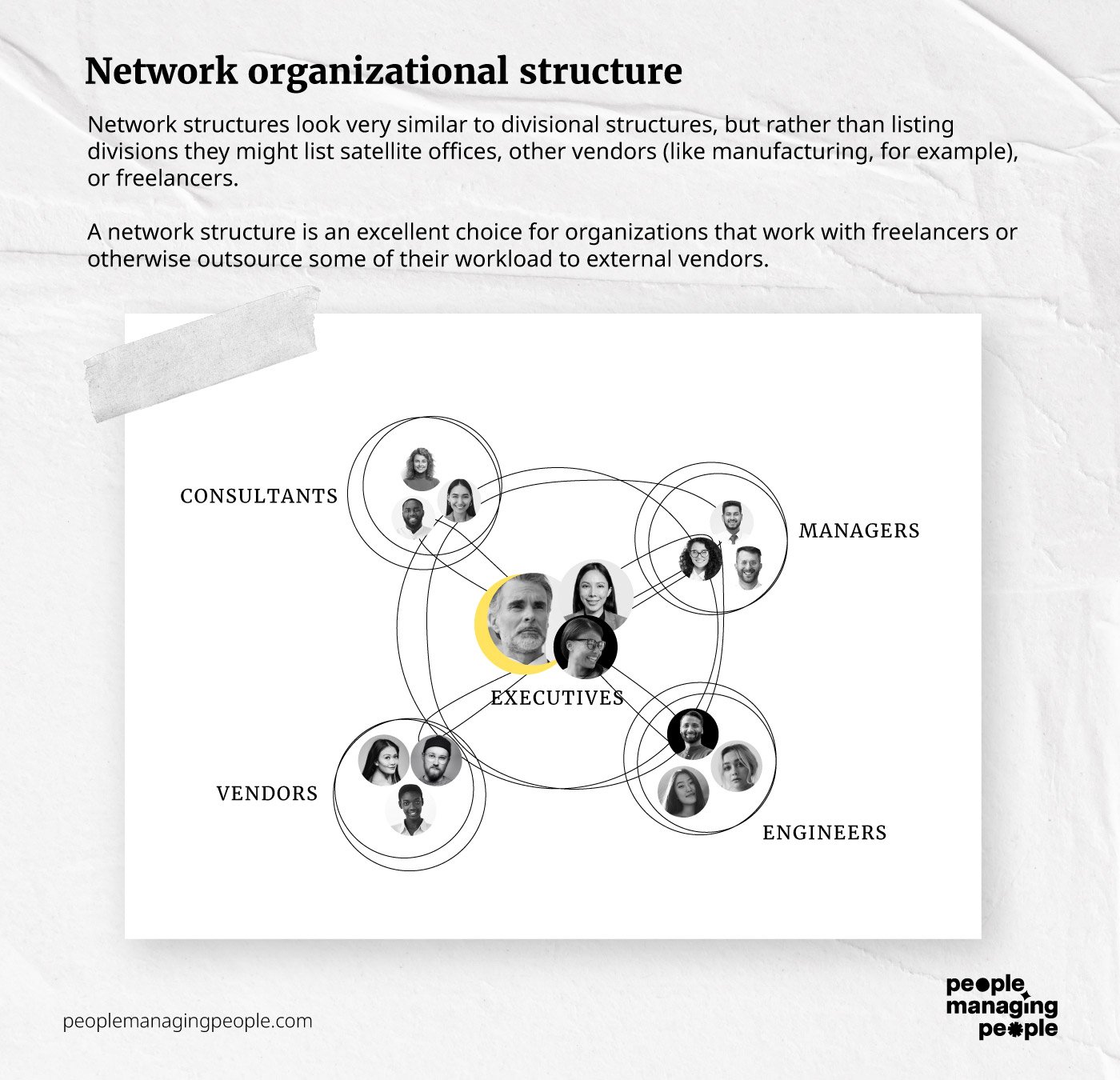
A network structure suits organizations working with freelancers or external vendors. It resembles divisional structures but includes satellite offices, vendors, or freelancers. It's useful for visualizing product lifecycles in large-scale operations or understanding the role of freelancers in smaller businesses.
Case study: H&M
H&M's success with a network structure is evident in its global supply chain. They collaborate with numerous suppliers and manufacturers worldwide, efficiently managing a vast product range. F
For example, H&M sources textiles from various countries, allowing them to offer diverse clothing options. This network-driven approach ensures flexibility, cost-effectiveness, and a constant flow of new products.
Prioritize agility by using a network structure. By building a network of global suppliers and partners, companies like H&M can quickly respond to market changes, reduce production costs, and maintain a constant flow of new products.
This agility allows businesses to meet customer demands effectively, providing a competitive edge in today's dynamic market landscape.
Pros of a network organizational structure
- Cost Efficiency: Outsourcing minimizes expenses and fosters flexibility, focusing on essential functions.
- Lean Operations: Avoids the need for extensive in-house departments, promoting competitiveness.
Cons of a network organizational structure
- Complexity: As more vendors and freelancers join, complexity may confuse new employees.
- Communication Clarity: Clear communication and role definitions are crucial to mitigate confusion in this structure.
How to Choose the Right Organizational Structure for Your Business
It's crucial to select a structure that aligns with your company's goals, culture, and operational needs. Here's a straightforward checklist to making this decision:
Step 1: Understand Business Objectives
Clearly define the company's strategic goals, including both short-term and long-term objectives.
- Key Considerations: Revenue targets, market expansion plans, and customer acquisition goals.
- Challenges: Aligning diverse stakeholder expectations, accurately forecasting future trends.
What you need to proceed: A clear set of goals, such as increasing market share by 20% in the next two years, launching three new products, or entering two new international markets.
Step 2: Assess Organizational Culture
Here you need to evaluate the existing culture, values, and work environment of the company.
- Key Metrics/Considerations: Employee engagement levels, turnover rates, company values.
- Challenges: Balancing diverse cultural elements, managing resistance to change.
- Outcome Needed to Proceed: Understanding of how the company culture aligns with various organizational structures.
An example of how a company culture can impact structure: Company X values innovation, employee autonomy, and a flat hierarchy, leading to high employee engagement but will face challenges in standardized processes.
3. Analyze Operational Needs
Consider the size, nature, and geographical spread of the business.
- Key Metrics/Considerations: Number of employees, types of operations, geographical locations.
- Challenges: Scaling operations, managing complexity across different regions or borders.
- Outcome Needed to Proceed: A clear view of the operational requirements and constraints.
For example: Recognition that the company operates across multiple time zones and requires a structure that supports both centralized decision-making and regional autonomy.
If operating across borders, particularly when it comes to hiring, a service such as an employer of record may prove to be a valuable partner for the business.
5. Consider Scalability and Flexibility
Plan for future growth and changes in the business environment.
- Key Metrics/Considerations: Projected growth rates, market volatility, innovation pace.
- Challenges: Anticipating future needs, maintaining flexibility.
- Outcome Needed to Proceed: A strategy that ensures scalability and adaptability.
You might need: A strategy that accommodates rapid scaling, particularly in digital spaces, with flexibility to adapt to changing market demands.
6. Choose a Structure Type
Make sure you choose a structure type that aligns with the company's goals and culture.
- Key Metrics/Considerations: Advantages and limitations of each structure type, alignment with company goals.
- Challenges: Making an informed choice, adapting existing processes.
- Outcome Needed to Proceed: Decision on a specific organizational structure type.
In some instances: You might decide to adopt a matrix structure, combining functional departments with project teams to balance expertise and innovation.
7. Solicit Feedback and Input
Regularly engage with employees at all levels for their insights and input.
- Key Metrics/Considerations: Employee feedback, engagement surveys, discussion forums.
- Challenges: Encouraging open communication, managing differing opinions.
- Outcome Needed to Proceed: Employee insights and buy-in for the chosen structure.
Example: Collected employee feedback might indicate support for more cross-departmental collaboration but concerns about potential role ambiguities in a matrix structure. These insights allow you to adapt and adjust.
8. Implement Gradually and Monitor
Roll out the new structure in phases and monitor its impact.
- Key Metrics/Considerations: Performance metrics, employee satisfaction, operational efficiency.
- Challenges: Managing the transition, addressing unforeseen issues.
An example of success looks like the initial rollout of the matrix structure in one department, leading to increased cross-functional collaboration, with plans to extend to other departments.
9. Be Open to Iteration and Change
Stay flexible and ready to make adjustments as needed.
- Key Metrics/Considerations: Ongoing performance reviews, feedback loops, adaptability measures.
- Challenges: Balancing stability with flexibility, continuous improvement.
What you're trying to achieve: Establishing a feedback mechanism to continuously assess the effectiveness of the new structure and readiness to make adjustments based on performance data.
Use Organizational Structures to your advantage
Choosing the best organizational structure for your business is one of the most effective ways to set your team up for success.
Key takeways:
Defines Decision-Making and Communication Flow: The structure of an organization determines how decisions are made and communicated. Hierarchical structures might centralize decision-making, while flatter organizations promote decentralized decision-making and often have more open lines of communication.
Shapes Company Culture: The organizational structure can reinforce or undermine the company culture. For example, a flat structure may support a culture of equality and openness, while a hierarchical structure may reinforce a culture of order and discipline.
Needs Periodic Review and Adaptation: As a business evolves, its organizational structure may need to be re-evaluated and adapted to ensure continued alignment with business goals and market conditions.
A related era you may want to focus on is organizational development. Attending a conference on organizational development will likely yield lessons that can impact how you view your organizational structures.
To remain up to date on all the latest in People Managing, don’t forget to subscribe to our newsletter. You’ll receive fresh insight and updates on all things HR and leadership, sent straight to your inbox.


